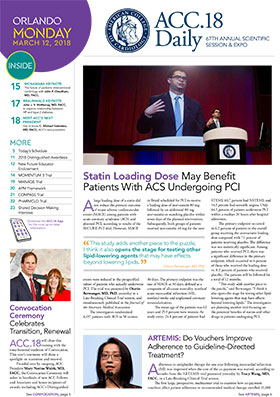Braunwald Keynote Explores Relationship Between HF and Type 2 Diabetes
The deadly intersection between type 2 diabetes and heart failure (HF) – two growing modern epidemics that feed each other – and what every clinician must know to effectively treat these patients is the focus of today’s Eugene Braunwald Keynote.
In a review of the current landscape, John J. V. McMurray, MD, FACC, will review clinical information and pose some questions about the basic mechanisms underlying the excess risk incurred in patients with HF who also have diabetes relative to those who don’t. The potential impact on therapeutic approaches will be explored, along with current treatment for diabetes in HF and new trials in the pipeline.
“Diabetes and its impact on HF is something every health care professional must understand,” says McMurray. “It’s no longer the domain for just endocrinologists or diabetologists. We must be in this together.”
"This has been an astonishing period of revelation and a period of rapid development of new trial protocols." — John J. V. McMurray, MD, FACC
McMurray, professor of cardiology at the University of Glasgow Institute of Cardiovascular and Medical Sciences in Scotland, is a well-known researcher in HF. He’s helped lead several important trials, including PARADIGM-HF, ATMOSPHERE, EMPHASIS-HF, RED-HF, CORONA, I-Preserve and CHARM-Added and he’s currently involved in running PARAGON-HF and Dapa-HF.
A remarkable discovery in recent years is that a new class of drugs for treating diabetes, called SGLT-2 inhibitors, substantially reduces the risk of developing HF, in addition to lowering glucose. Until then, glucose-lowering drugs had a mixed track record, with some increasing HF and some reducing it.
The EMPA-REG OUTCOMES trial with empagliflozin and the CANVAS trial with canagliflozin both demonstrated a 30-35 percent reduction in HF hospitalization. “This means these drugs may be a treatment for patients with diabetes at risk of developing HF, and possibly they could be used to treat patients with diabetes who already have HF,” McMurray says.
Some data show HF is the most common cardiovascular complication of diabetes. It’s certainly the most deadly. Conversely, diabetes as well as pre-diabetic dysglycemia are very common in HF. “Only the minority of HF patients have a normal glycated hemoglobin,” notes McMurray. “We don’t fully understand why HF patients with diabetes do so badly or why dysglycemia is so common in HF,” he adds.
What’s the scope of the problem? Among middle-aged adults, about 20 percent are likely to develop HF – and the risk is doubled in individuals with type 2 diabetes. HF incidence is somewhat lower in women and they’re more likely to have HF with preserved ejection fraction and men more commonly have a reduced ejection fraction. Women with HF tend to have a better prognosis than men.
Several new clinical trials are now enrolling patients with established HF to explore whether SGLT-2 inhibitors can improve their outcomes, McMurray says. He anticipates within two years there will be results to show whether there’s a much broader indication for these drugs, particularly in this new super-sick population of patients with HF and diabetes or pre-diabetic dysglycemia.
“It is an eye-opener in terms of recognizing that at long last we may be able to do something for this group of high-risk individuals. This has been an astonishing period of revelation and a period of rapid development of new trial protocols,” says McMurray.
Keywords: ACC Publications, ACC Scientific Session Newspaper, ACC Annual Scientific Session
< Back to Listings

